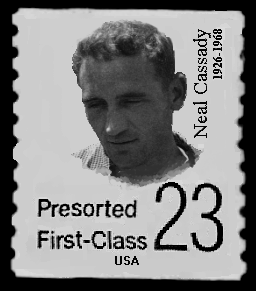
Neal Cassady
Born: February 8, 1926
'The bus came by and I got on, that's when it all began
'N.C., secret hero of these poems ...'
The real genius behind the Beat movement in literature never published a book during his life. He appeared as a main character in many books, though, from 'Go' by John Clellon Holmes to 'On The Road' by Jack Kerouac to 'The Electric Kool-Aid Acid Test' by Tom Wolfe. His free-flowing letter writing style inspired the young Kerouac to break his ties to the sentimental style he'd picked up from Thomas Wolfe and invent his notion of 'spontaneous prose.' Without Neal Cassady, the Beat Generation would never have happened. Neal Cassady was raised by an alcoholic father in the skid row hotels of Denver's Larimer Street. A car thief with a unique ability to charm strangers, he spent time in reform schools and juvenile prisons and developed the suave instincts of a con artist, although he never seemed to want to con anybody out of more than a ten-dollar bill, a roll in the hay or a good conversation. A friend named Hal Chase left Denver to enroll at Columbia University, and Cassady traveled to New York to visit him in December 1946. It was here that he met Kerouac and Ginsberg. Ginsberg immediately fell in love with him, and Cassady, who had a hustler's instinct to be whatever the person he's with wants him to be, began a sexual relationship with Ginsberg, balancing it with the numerous heterosexual relationships he enjoyed more. At the same time, he persuaded Kerouac to teach him how to write fiction. Soon he and Kerouac began the series of cross-country adventures that would later become 'On The Road'. They raced aimlessly across the U.S.A. and Mexico, with Cassady setting the agenda. Kerouac began writing about their adventures even as they were taking place, but he could not find a style that fit the content, and put the project away in frustration. He picked the project up again later, after a series of letters from Cassady gave Kerouac the idea to write the book the way Cassady talked, in a rush of mad ecstasy, without self-consciousness or mental hesitation. It worked: 'On The Road' became a sensation by capturing Cassady's voice.
Cassady married several women and fathered many children (much of this activity
is discussed in 'On The Road'). He finally settled down with
Carolyn Cassady
in Los Gatos, a suburb near San Jose, where he worked as a brakeman on the
Southern Pacific
railroad. He remained close friends with Ginsberg, Kerouac and many
others from the Beat crowd, although he never profited from their eventual
success. Kerouac wrote in
'Desolation Angels'
of the strange way he felt when Cassady dropped by his
apartment after the first advance copies of 'On The Road' arrived:
When Kesey and Cassady were in New York, a party was organized for the purpose of introducing Kerouac to Kesey. But Kerouac and Cassady had been changing in opposite directions, and the meeting did not go well, especially after Kerouac, offended by somebody's frivolous treatment of an American flag, solemnly rescued the flag and folded it. After a night of hard partying in Mexico in 1968, Cassady wandered onto a deserted railroad, intending to walk fifteen miles to the next town. He fell asleep on the way, wearing only a t-shirt and jeans. It was a cold rainy night, and Cassady was found beside the tracks the next morning. He was in a coma, and died in a hospital later that day. Kerouac would die a year later. Neal's unfinished autobiography was published as 'The First Third' after his death. Some of his letters, such as the one Kerouac called 'The Great Sex Letter,' were also published.
In the autumn and winter of 1995 I conducted an extensive e-mail interview with John Cassady, Neal's son. Here's another interview (conducted by Bill Horbaly, a Cassady relative himself) with several of Neal's adult children. Andrew Burnett wrote a heartfelt tribute to the city of Denver and the streets Neal Cassady walked. It's illustrated with many photos of places mentioned in the Beat classics. Here's Neal's Denver. A list of books, tapes, videos and other things relating to Neal is here. Finally, here is Tim Bowden's fascinating memoir of his relationship with Carolyn Cassady a few years after Neal's death. There are some interesting insights here, and we encounter quite a few marginal Beat legends and 'On The Road' characters as well.
Literary Kicks
AMBA HOME PAGE |